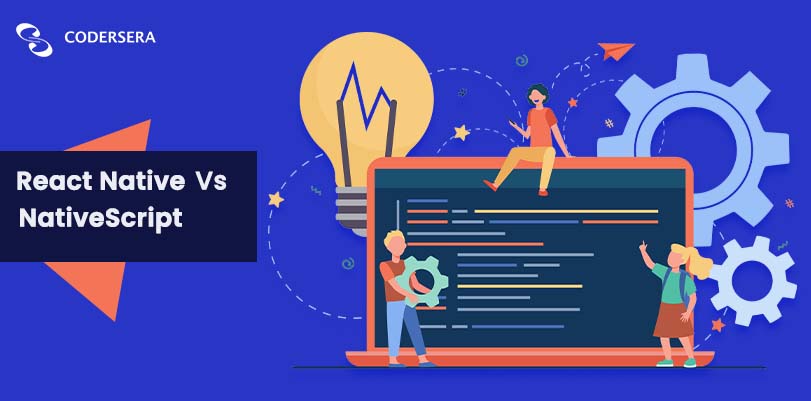- Home
- >
- Mobile apps development
- >
- Which to Choose For Cross-Platform App Development? React Native vs Javascript
Cross-platform app development is the process of building mobile apps from a single codebase for Android, Apple OS, and Windows instead of creating separate applications for specific operating systems.
While this approach is cost-effective and saves tons of time, developers have had to sacrifice the quality of app performance and user experience previously. Even though the apps were built using the same codebase, the technology prohibited them from delivering the same level of service throughout.
With mobile app frameworks such as React Native and NativeScript, however, developers have broken free of the limitations that cross-platform app development brought on the table and no longer need to maintain excessive overhead in the form of two or more overheads.
They can conveniently build native-like apps with a single codebase — offering a seamless user experience across all operating systems. Here are three more benefits that they enjoy:
- Shortened time-to-launch — Cross-platform app development is 50% faster than native development.
- Low maintenance — Fixing the code of one application is cheaper than maintaining two separate apps. It does not burn a hole in the packet.
- Serve to a larger audience — With a cross-platform app, they can serve users on Android, Apple OS, and Windows and do not have to choose between them, especially with a limited budget.
If you are also looking to build a cross-platform app but cannot decide between React Native and NativeScript, this article will help you make the right decision. Let us go!
Key Summary
This InApps.net article, published in 2022 and authored by Phu Nguyen, compares cross-platform app development frameworks, focusing on React Native and NativeScript. Written with a technical, decision-oriented tone, it aligns with InApps Technology’s mission to cover software development trends, guiding developers in choosing the right framework for cross-platform apps.
Key Points:
- Context: Cross-platform app development enables building apps for Android, iOS, and Windows from a single codebase, historically sacrificing performance but now improved by frameworks like React Native and NativeScript.
- Core Insight: React Native and NativeScript offer native-like performance with a single codebase, reducing development time and costs while reaching broader audiences, with React Native being particularly popular (42% of developers used it in 2020, per Statista).
- Key Features:
- Cross-Platform Benefits:
- Time Efficiency: 50% faster than native development, shortening time-to-launch.
- Low Maintenance: Fixing one codebase is cheaper than managing separate apps.
- Broad Reach: Targets users across Android, iOS, and Windows without choosing platforms.
- React Native:
- Open-source framework by Facebook, combining JavaScript and XML-esque markup (JSX).
- Focuses on native rendering, communicating with native APIs for Android and iOS.
- Benefits: Fast development, reusable UI components, and strong community support (11.5% of developers prefer it for reliability).
- NativeScript: Enables cross-platform development with native performance, supporting JavaScript and TypeScript, with access to native APIs.
- Comparison: Both frameworks deliver seamless user experiences, but React Native’s popularity and ecosystem give it an edge for many developers.
- Cross-Platform Benefits:
- Outcome: Cross-platform frameworks like React Native and NativeScript streamline app development, with InApps supporting businesses in selecting the best framework for efficient, high-quality app delivery in 2022.
This article reflects InApps.net’s focus on mobile app development trends, providing a practical, inclusive guide to choosing between React Native and NativeScript for cross-platform projects.
An introduction to React Native
An open-source mobile application framework, React Native, is written combining JavaScript and XML-Esque markup and was developed by Facebook, Inc. It focuses on the native rendering of apps compatible with Android and iOS.
In other words, it is a UI component library consisting of React using JavaScript. These components convert the code for the chosen operating system as they can “talk” with native APIs. The developers work faster and can create on iOS versions faster, and also work on Android app development using React Native.
According to Statista, 42% of developers opted for React Native app development in 2020, and 11.5% prefer using the framework because of its reliable native tools and libraries.
Pros
1. Native rendering
In mobile app development with React Native, the latter uses the host platform to render APIs natively. There is no need for CSS or HTML markups in this process. The rendering process is fairly simple.
2. Rich ecosystem
React Native leverages its rich ecosystem of UI libraries and codebases to re-render app appearances automatically, with every state change.
3. Hot-loading
Do you want to deploy a framework that can add new codes directly into a live application? React Native can do so. Two apps for two different platforms can be developed simultaneously, thereby saving time and effort for developers.
4. Easy debugging
It provides instant access to intelligent error reporting and debugging tools. That way, developers can build new, error-free apps for different operating systems without any hassle.
5. UI mimicry
The framework translates the markup of the application to “act” like the authentic UI elements. Even by doing so, the app can deliver a seamless performance across platforms and devices — which is the end goal of using cross-platform app development frameworks.
Cons
1. User interface
The app UI may look a little off or ill-formatted at times as the native rendering of APIs does not support certain native UI elements.
2. Slow performance
React Native does not support multi-processing and parallel threading, which can make the apps on a new operating system perform slightly slower.
3. Faulty Chrome debugger
This might make it inconvenient for developers to edit and inspect codes and UI elements properly.
4. Outdated tools
Sure, many third-party and external libraries can be used for implementing React Native. However, often, these resources turn out to be outdated or redundant.
How React Native has made a difference?
React Native is like a Swiss Army knife — it addresses developing and managing complex UI efficiently. When you think of React UI components, picture them as self-contained functionality blocks. Naturally, this framework has been used by many companies, namely:
1. Bloomberg
The Bloomberg developers created the app to ensure their users had a similar experience on mobile and desktop. React Native helped them accelerate iterations, automate code refreshes and enable quick feature upgrades. They streamlined simple-to-access, personalized content for users via the framework — in five months!
2. Walmart
The retail giant improved the user experience by building smooth in-app animations, including straightforward UI, identical to the native functionalities through React Native. Besides, they cut down on time frames and resources. Today, the mobile platforms share 95% of Walmart’s codebase.
3. Facebook
As the homeland of React Native, Facebook developers have significantly reduced the iterations occurring across all versions of the app. Their new Events dashboard delivers improved performance and UX on mobile. Plus, they have created supportive iOS and Android UIs, with simple navigation, two times faster.
4. Wix
Wix provides a library to its users for delivering a native experience on the app. It is called Wix React Native Navigation. The solutions offered by them can be adjusted to suit the user’s app requirements and help achieve high speed and agility in developing configurable navigations and screen options.
React Native is perfect for building quick prototype applications with simplified UI or that look nearly native with responsive UX or apps that operate with synchronous APIs.
An introduction to NativeScript
NativeScript is an open-source framework helpful in building cross-platform applications. Just like ReactNative, it also uses JavaScript for Android and iOS. It was initially conceived and developed by Progress. It was taken over by nStudio, a long-term Progress partner, in 2019.
With NativeScript, developers can reuse concepts and knowledge of existing frameworks such as AngularJS, TypeScript, or Vue.js to build applications traditionally having native elements, delivering native performance.
According to Statista, only 5% to 11% of developers use NativeScript for cross-platform application development. However, 27% are committed to using this framework for more than a year for various custom App development projects.
Pros
1. Cross-technology compatibility
NativeScript uses JavaScript, TypeScript, and AngularJS during the app development process, allowing efficient data binding and stronger component reusability.
2. Higher extensibility
The framework gives complete and direct access to all Android and iOS APIs and encourages developers to reuse free plugins, CocoaPods, and Android SDKs. This makes their job more uncomplicated and time-saving.
3. Programming language usability
NativeScript leverages an XML-Esque-based markup language such as HTML and CSS to develop cross-platform applications with personalized features.
4. Developer-friendly CLI
The command-line program of the framework enables developers to carry out a range of tasks, such as adding a platform to deploying apps on a specific device or platform. Thanks to the CLI, installing plugins and debugging apps is faster and more convenient.
5. Native functionality
The developers can access native device API services through native components, enabling a fine native app-like experience on other platforms.
Cons
1. More unverified plugins
Given the enormous volume of plugins, there is little assurance about the quality of plugins used in this framework. In fact, the number of verified plugins is significantly less.
2. UI limitation
HTML and DOM are not widely supported in NativeScript. That makes it necessary for developers to learn using different UI components, leading to an increased chunk of the project budget and time.
3. Slower testing
Given the native nature of the application, it can only be accurately tested on an actual device or an emulator. This factor often slows down the initial testing rate.
4. Steep learning curve
Developers working in NativeScript must have basic knowledge about native functionalities and APIs of both Android and iOS. Otherwise, they will not access any device’s hardware or work on any platform-specific elements.
How NativeScript has made a difference
This framework enables an improved ability to code iOS and Android app, with 100% element-sharing and 90% code-sharing capabilities. It has also proven to bring down the development rate by 40%. Here are a few brands that have used NativeScript:
1. PUMA
Using NativeScript, the sportswear brand built high-quality, simple-interface mobile apps in a short span. They could also integrate on-demand native features such as push notifications, messaging, and user authorization with cloud storage capabilities.
2. SAP
SAP used NativeScript to build its mobile development kit that enabled higher code abstraction levels without hampering the system network. SAP was able to render JavaScript codes into applicable native codes by applying sophisticated business logic.
3. Portable North Pole
Using NativeScript, the personalized Christmas video and call maker could enhance and diversify platform compatibility without affecting the user experience in any way. They developed a separate UI kit that functioned efficiently with native applications, equipped with ready-to-use mobile components, icons, and features.
4. Airbnb Design
The design wing of Airbnb used the framework along with Lottie to deliver native performance and built creative UI elements that quickly rendered After Effects animations in real-time. Besides, developers were able to manipulate code as per the native design.
NativeScript is apt for building apps with massive server connectivity, essential gaming apps, geolocation apps, and music or video streaming apps. If you want to develop an application which can function with the default apps of the device, NativeScript is the right option for you.
Parameters to consider while choosing between React Native and Native Script
1. Experience of development teams
React Native does not have a dedicated IDE. Instead, React Native developers have the liberty to choose whichever code editor they prefer. But since there is no official tool support, they would have to set up everything from scratch, including picking debugging tools independently.
On the other hand, the NativeScript developers can set up the environment through a single line of code. They also use a comfortable set of tools for easing the debugging pain-point. If you use Visual Studio Code, please use a free debugging plugin made especially for NativeScript.
2. Performance analysis
iOS mobile apps made with both frameworks run at 60fps at runtime. This speed is similar to apps built on Swift or C#. However, if we take the example of NativeScript, it uses a multi-threading model to offload long-running processes, optimizing front-end speed.
On Android, React Native used to take the cake until 2016, when it could load up to 1.5 times faster than NativeScript. Even today, there might be some differences depending on the type of platform, viewing device, and application used.
3. Flexibility in testing
React Native gives developers complete freedom when choosing the most efficient test automation framework, for instance, Appium, Espresso, UI Automation, Frank, Calabash, and so on. On the other hand, NativeScript allows developers to use their own QA workflow, and they can run tests straight from the framework’s CLI — through Quint, Mocha, and Jasmine. Both frameworks are flexible when testing but in their ways.
4. Code maintenance
The biggest reason businesses decide to go ahead with cross-platform frameworks is the ease with which mobile platforms and even web and mobile apps can share code amongst themselves.
Of course, the percentage of code that can be reshared on mobile and web heavily depends on the app functionalities, and this difference usually comes from the fact that every component is a piece of UI. Cross-platform development tools based on React Native can save you time and help in quick bug fixing. But only up to 70% of code can be reused.
Alternatively, NativeScript can reuse up to 90% of the code because it provides standard API services for all common functionalities in iOS and Android platforms. Moreover, there is no indifference between JavaScript and UI rendering. However, in the case of NativeScript, there is a possibility of the app getting stuck whenever intensive Java code is executed.
5. Size of the application
When it comes to app size, React Native wins big. Since it is without any framework-specific burden, its APK is light and small, which can be further used on applications of any size. However, NativeScript installers are enormous, even for apps with similar functionalities.
But when they are installed, both solutions are the same in size. The Vue implementation is the only case comparable with React Native in terms of file performance and app size.
6. Community support
Working on a specific framework or technology is easier when there is a large community base to back you. Since both React Native and NativeScript grew at a rapid pace, that is because of the many active contributors who were willing to share information on basically any question or issue you may have on cross-platform app development.
But if you compare the two, React Native certainly has a more extensive community support system than NativeScript. That is because Facebook’s development team was behind it — who are well known worldwide.
The former’s community is responsible for the framework’s vast repository of third-party plugins and libraries. Plus, it is also easier to find developers experienced in the framework, as the available dev pool is much larger.
That makes it easier for businesses to jumpstart a new project on React Native and quickly put together a team that can handle it.
7. Technologies used
React Native uses React JS for development purposes. On the other hand, NativeScript leverages AngularJS, Vue.js, and TypeScript for the job.
8. Development workflow
In both frameworks, developers create a new project, deploy components or widgets to build UIs, apply custom layouts and styling, add required functionalities, run tests on the emulator or simulator and debug the app.
The only difference is NativeScript can debug the app with Visual Studio Code to debug, whereas React Native developers use Reactotron or React Native Debugger to do the job.
Conclusion
As you would imagine, there will be no definite winner in this comparison because the decision is ultimately dependent on the availability of dependable and competent experts skilled in either framework.
When deciding between NativeScript and React Native, bear in mind that you can need some native-language adjustments during the development process to optimize the output and user experience of apps for a particular platform- more so if you’re creating a robust, feature-heavy application. That being said, make sure to hire developers with extensive knowledge and experience in the required field. Codersera always comes in handy to meet your hiring needs to the fullest.
NativeScript is the wisest option for rendering Angular or Vue. js web apps to mobile versions. React Native is ideal for those who are just getting started in this field and have no previous experience with mobile development.
If your app is UI/UX oriented, React Native is a great option because it has a plethora of libraries available. If you are acquainted with React, creating an app with React Native is simple. It offers a quick development tool and, yes, it has a great future.
It is faster than a hybrid app and has no limitations in terms of development. The learning curve is typical. Nativescript gives you access to the underlying platform’s native APIs. It is unquestionably worthwhile to give Nativescript a shot.
It is commonly used, and some of its popularity can be attributed to the success of React. React developers can quickly get on board and build React Native mobile applications. Today, React Native is used for mobile apps by products such as Facebook, Instagram, Uber Eats, Tesla, Bloomberg, and many others.
Source: InApps.net
[sociallocker id=”2721″]
List of Keywords users find our article on Google:
| react native navigation |
| nativescript |
| android app development |
| nativescript development company |
| select the app that developed in nativescript |
| cross platform app development |
| react native app template |
| build an app like uber |
| app development platform |
| linkedin debugger |
| hire espresso developers |
| react native templates |
| react native error reporting |
| native script |
| react native app templates |
| react native expo |
| react native template |
| ecommerce ui kit |
| react native messaging app |
| offshore cross-platform app developing service |
| nativescript mobile app development company |
| react native video processing |
| codebase technologies |
| react native cocoapods |
| react native chat app |
| hire mocha developers |
| chat app in react native |
| react native live chat |
| react native push notifications |
| react native android emulator |
| on demand delivery app development |
| custom application development |
| airbnb ho chi minh |
| native ux experts |
| react native template design |
| react native design templates |
| react native developer jobs |
| hire redux developers |
| sap work manager mobile app |
| react native video |
| c# ui framework |
| template react native |
| rapid application development android |
| on demand uber app development |
| “cross-platform” “development” |
| hire xml developers |
| cross sportswear |
| lottie react native |
| vue js jobs |
| vue instant search |
| expo react native |
| templates react native |
| react native emulator |
| react lottie |
| airbnb message templates |
| sap rapid application development |
| create an app like uber |
| how to build an app like uber |
| nativescript vs react native |
| hire appium developers |
| reactotron |
| typescript jobs |
| wix app market |
| hire visual basic developers |
| develop app sap |
| react native on visual studio code |
| react native build apk |
| template app react native |
| chat app react native |
| react native desktop |
| react native web |
| react native ecommerce |
| react native with visual studio |
| web development workflow |
| android mobile development |
| vue vs react |
| nativescript video |
| airbnb lottie |
| react native render html |
| hire play framework developers |
| developers facebook apps |
| react native multi select |
| lottie-react-native |
| appium with c# |
| sap field service mobile app |
| native script logo |
| wawa hiring process |
| react native geolocation |
| cross-platform app development |
| hire instagram api developers |
| react native apple sign in |
| react native share file |
| react-native-video |
| wix hire a partner |
| appium studio |
| react native ui template |
| espresso vs appium |
| react native mobx tutorial |
| react native responsive ui |
| on press react native |
| react native screens |
| react native shared |
| vue.js error tracking |
| wix vietnam |
| react native message |
| offshore cross-platform app making service |
| appium vs espresso |
| appium android example |
| appium javascript |
| develop mobile application sap |
| develop mobile app sap |
| react native android device |
| mobile app ui kit |
| app development firms |
| ios app development |
| android application development |
| react native app development agency |
| no code android app development |
| app development |
| on demand delivery app development company |
| tam nguyen facebook |
| wix editor x vietnam |
| appium java client |
| application portfolio tools with xml input |
| tesla qa jobs |
| nativescript video player |
| phunware offering |
| nativescript app icon |
| react keywords |
| react-native-phone-input |
| nativescript start |
| facebook create react app |
| appium capabilities |
| apps made with nativescript |
| react native scheduler |
| nativescript form |
| react-native-progress |
| statista airbnb |
| airbnb message template to host |
| react native geolocation service |
| angularjs jobs |
| vue js developer jobs |
| select in react |
| react native native video player |
| vue.js developer jobs |
| react-native-device-info |
| edtech live chat outsourcing |
| game sportswear phone number |
| react native navigation params |
| react native ui design template |
| vue.js jobs |
| wix automations integrations |
| mobx-react-form |
| appium desiredcapabilities example |
| react real estate template free |
| sap mobile platform |
| custom vision api c# |
| react native screen |
| wix web app |
| react native permission |
| react native phone number |
| appium android real device capabilities |
| react native elements input |
| appium server capabilities |
| react native responsive |
| @react-navigation/native-stack |
| sap mobile applications |
| react native video chat |
| react-native-elements |
| appium c# |
| react native navigation options |
| react native video call sdk |
| sap mobile development kit |
| react phone number input |
| send message on whatsapp using c# |
| crossplatform app development |
| airbnb typescript |
| hire cli developers |
| navigation options react native |
| portfolio website using react |
| appium command not found |
| nativescript android app |
| nativescript development companies |
| react native video editor |
| appium real device android |
| debugging in vue.js |
| react native live video streaming |
| react native video call |
| react native video app |
| let’s sacrifice toby |
| nativescript developer |
| visual studio code react native |
| appium android capabilities example |
| outsource real estate image editing vietnam |
| react-native video editor app |
| react native template typescript |
| react native visual studio |
| sap field service mobile application |
| appium for android |
| react native navigation android |
| uiautomation ios |
| hole maker technology |
| visual studio react |
| api.whatsapp.com parameters |
| react native elements |
| react native game |
| real time developer notifications android |
| vue.js debugging tools |
| react native windows app |
| appium framework |
| c# ui library |
| react native apple |
| react native visual studio code |
| appium app |
| react native android debug |
| uber eats delivery tutorial |
| wawa app |
| java appium example |
| visual studio apps for android |
| live search react native |
| visual studio code debug react typescript |
| appium android |
| appium ios |
| net core ui |
| jobs react native |
| react native appium |
| react native without android studio |
| accelerated ui ux design class |
| react native performance profiling |
| react visual studio 2019 |
| no code ios app maker |
| how to create an app like uber eats |
| how to develop an app for android |
| android software development |
| cost to develop fintech app |
| on demand mobile app development company |
| mobile app development company |
| mobile app development services |
| multi platform app development |
| nativescript vs react native performance |
| best cross platform frameworks |
| cross platform app development 2022 |
| cross platform dev |
| nativescript jobs |
| airbnb ho chi minh district 2 |
| react native navigation wix |
| react native linkedin |
| react native wix navigation |
| wix navigation react native |
| wix react native |
| scratch imagine program share |
| lottie visual studio code |
| knife simulator script |
| sap.ui.commons |
| tan app icons |
| wix navigation |
| hcmc message board |
| nativescript plugin |
| wawa hiring |
| appium java client version |
| hire branch io developer |
| nativescript ios development service |
| platform frame walmart |
| mocha ae vs mocha pro |
| react native wix |
| who uses nativescript |
| walmart swiss army knife |
| nativescript version |
| wix cross |
| convert angular to nativescript |
| react native select |
| update available for component nativescript |
| wix apps |
| nativescript typescript |
| personalised christmas iphone 6 covers |
| sap mobile application studio |
| sap profile parameter table |
| “expo logic” |
| icon nativescript |
| personalised christmas iphone 6 cases |
| personalised christmas iphone 6 cover |
| free lottie animations |
| nativescript core |
| react-native-community cli |
| nativescript developer jobs |
| phone input react native |
| select in react native |
| choose for |
| nativescript ios |
| personalised monogram iphone 5 cases |
| sap debugging |
| capabilities appium |
| wix trustpilot |
| build apk expo react native |
| expo push notifications react native |
| hire appium developer |
| nativescript design |
| sap react js |
| simulate touch events chrome |
| react native game engine tutorial |
| angular and nativescript |
| appium studio pricing |
| nativescript get app version |
| react native device info |
| visual studio 2022 vs 2019 performance |
| convert expo project to react native |
| crash reporting tool webapp |
| hire twitter api developer |
| nativescript android studio |
| nativescript tutorial angular |
| offshore platform icons |
| react native navigation expo |
| sap commerce integration api xml |
| appium c# example |
| appium ios capabilities |
| nativescript service |
| personalised christmas iphone 7 covers |
| portablenorthpole |
| visual studio 2019 very slow debugging |
| code push react native |
| nativescript android |
| nativescript versions |
| phone number input react |
| qualee-technology |
| spartak cake |
| video chat react native |
| vs code react native debugger |
| appium find all elements |
| how nativescript works |
| puma seamless |
| react native loading component |
| wix android |
| c# appium |
| choose app |
| nativescript android version |
| react-native-phone-number-input |
| running appium tests on real devices ios |
| appium tutorial point |
| react native ecommerce template |
| react native typescript expo |
| wawa app not working |
| android studio nativescript |
| appium get device info |
| nativescript performance |
| react input phone number |
| react lottie web |
| react native community geolocation |
| react navigation/native |
| visual studio code debug android device |
| wix courses app |
| airbnb message to host template |
| personalized christmas story |
| react native music app |
| react native phone number input |
| wix workflow |
| eve online enable hardware rendering |
| expo react navigation |
| performance tools for visual studio 2019 |
| portable north pole |
| react native ecommerce app tutorial |
| react native lottie |
| sap developer center |
| tesla front end developer |
| appium real device ios |
| debug vue js |
| how to find element in appium ios |
| react native device id |
| react video call component |
| react-native-geolocation-service |
| sap user authorization |
| visual studio 2022 angular |
| appium ide |
| appium pro |
| field outsource asia inc |
| react native navigation screen options |
| react-native-navigation |
| stack navigator react native |
| what is native script |
| wix editor not loading |
| calabash android |
| delivery app ux |
| instant search react |
| react native eject |
| react native elements expo |
| react native without expo |
| appium capabilities for android emulator |
| appium java example |
| apps script range |
| experience cloud debugger |
| react native instagram stories |
| react native make apk |
| react native stack navigator |
| react native web template |
| react-native-render-html |
| visual studio cross platform |
| android app developer jobs |
| long press react native |
| lottie free animations |
| lottie library android |
| native base react native |
| nativescript example apps |
| new builds calabash |
| portfolio website using react js |
| react native code input |
| react native run android specific device |
| react native run simulator |
| react-phone-input-2 |
| appium community |
| appium ios app |
| appium ios simulator |
| free react native templates |
| issues surrounding the decisions to build and/or host your own ecommerce site or to outsource some aspects of site development. |
| nativescript apps |
| phunware inc |
| react native official site |
| react native run android on device |
| react-native-share-menu |
| rerender vue |
| sap web ide |
| visual studio community 2022 |
| wix events app |
| app center react native |
| app library sap |
| cli elearning |
| hire jasmine developer |
| open source reporting tools for angular |
| portfolio using react js |
| react debugging vscode |
| react native cli vs expo |
| react native launch screen |
| react-native-share whatsapp |
| react-native-touch-id |
| video editor react native |
| wawa christmas hours |
| airbnb experiences dashboard |
| airbnb statista |
| android databinding |
| appium client |
| appium java version |
| appium language capability |
| appium real device |
| custom monogram iphone 5 case |
| easing react native |
| hire facebook api developer |
| in app messaging react native |
| multiprocessing pool |
| mvp streamline |
| nativescript desktop |
| react native device |
| react native in app chat |
| react native menu |
| react native testing library |
| react native with visual studio code |
| react sap |
| react-native-vide |
| run appium on real android device |
| sap mobile platform overview |
| sap operating systems |
| appium c# android example |
| appium javascript example |
| higher logic frameworks |
| phone number react native |
| portfolio reactjs |
| react native video calling app |
| angular lottie |
| appium get screen size |
| debug vue.js |
| expo cli |
| portable.north pole |
| react native icons expo |
| react native navigation style |
| react native receive email |
| rich text editor vue 3 |
| update expo cli |
| android app development jobs |
| appium job support |
| calabash vs appium |
| in-app messaging case studies |
| offshore streaming server |
| portfolio website with react |
| react native in visual studio code |
| react-native push notifications |
| redux-form file upload example |
| run appium test on ios simulator |
| select react native |
| what is walmart’s hours on christmas eve |
| airbnb api for developers |
| android app ui kit |
| appium sample code for ios in java |
| c# if debug |
| hire facebook api developers |
| hybrid app appium |
| java runtime environment 1.5 |
| little giant platform |
| mobile app development costs and timeframes |
| navigation in react native |
| portfolio website react |
| reac native elements |
| react native desktop app |
| react native food delivery app with backend |
| react native tutorial point |
| airbnb quality assurance |
| appium mobile commands |
| bear development team |
| hire espresso developer |
| hire jasmine developers |
| portfolio website in react |
| react native input field |
| react native live stream |
| react-native-phone-call |
| react-phone-number-input |
| server error uber eats |
| visual studio android |
| wix profile maker |
| appium ios tutorial |
| calabash authentic |
| develop application sap |
| device id react native |
| expo android emulator |
| messaging ui swift |
| mobile apps sap |
| nativescript build ios |
| navigation react native |
| quick base application |
| react in visual studio code |
| react js game engine |
| react native facebook |
| react native for desktop |
| react native input |
| react native template free |
| react native video api |
| react navigation react native |
| react redux form file upload |
| sap javascript |
| sap mobile maintenance |
| sending whatsapp message using c# code |
| wix tutorial |
| appium hybrid app testing |
| appium react native ios |
| build react native app with expo |
| convert angular app to desktop app |
| delivery simulator script |
| facebook developer tools |
| how to turn off offload apps |
| mobx |
| multiprocessing.process |
| react native ecommerce app |
| react native share |
| redux form file upload example |
| typescript in vuejs |
| vue js ecommerce template free |
| wix app for android |
| wix web development |
| appium android chrome |
| appium android emulator |
| appium desktop tutorial |
| appsnet |
| custom logo puma |
| developers.facebook/apps |
| expo vs cli |
| lottie react |
| lottie tan time |
| multiplatform mobile app development with nativescript |
| platform vs framework |
| react native dashboard template |
| react native geolocation example |
| react native ios emulator windows |
| react native kit |
| react native multithreading |
| react native profile picture upload |
| react native run android emulator |
| react visual studio code |
| reactnative web |
| redfox web design |
| responsive react native |
| swift ui chat |
| three js react native |
| c# #if debug |
| messaging app ui kit |
| mobile app using c# |
| react debug |
| react native appium testing |
| react native icons |
| react native responsive screen |
| react native run android |
| react native send email from app |
| react native streaming video |
| react native typescript template |
| react native windows |
| react rerender |
| real estate react template |
| wix mobile menu |
| appium java |
| appium react-native |
| backend for react native app |
| create react app debug |
| create react native app with expo |
| hire three.js developers |
| java appium |
| jobs for android developers |
| react native for web |
| react native input number |
| react native number only input |
| react native send email |
| react native video player component |
| react-native-network-info |
| sap mobile development |
| angularjs widget |
| create stack navigator react native |
| multithreading c# |
| native base icons |
| react native app automation using appium |
| react native push notification ios |
| react native send message to whatsapp |
| react native video upload |
| sap mobile applications development |
| select reactjs |
| video streaming react native |
| visual studio android development |
| vue debugging |
| walmart backend keywords |
| m-commerce usability |
| sap success stories |
| sap android im mobile |
| vue ui components |
| sap mobile solution |
| creating a simple android app |
| react vs react native |
| cross-curve |
| android app development company |
| apps like seamless |
| fintech app development cost |
| outsource react native development |
| is ui and front end the same |
| android development company |
| android app development company usa |
| software test automation framework |
| android app developers |
| hire app developers |
| react native app development |
| mobile app development company usa |
| mobile app development |
| native app development |
| develop mobile application |
[/sociallocker]
Let’s create the next big thing together!
Coming together is a beginning. Keeping together is progress. Working together is success.



















